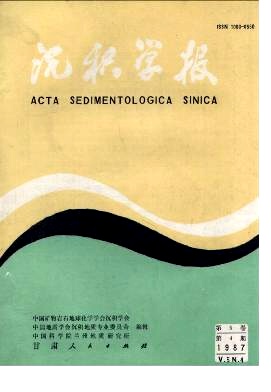STUDY ON THE CHARACTERISTICS OF PLEISTOCENE DOLOMITE AND THE ORIGIN OF DOLOMITIC TUBULES OF PAIPU IN HAINAN ISLAND
- Received Date: 1985-12-09
- Publish Date: 1987-12-10
Abstract: The pleistocene dolomite crops out the erosion flat of a intertidal zone and on the cliff of the supratidal zone of Paipu in the Hainan Island as the first recent dolomite discovered in China, 1981. The total thickness is more than 4m. It can be subdivided into 7 beds, the upward succession is as follows: pebbled coarse sandy bed(nondiagenetic) i dolomitic fine grained stone dolomitic tubular fine sandstone; dolomitic medium grained sandstone, dolomitic tubular fine sandstone, dolomitic pebbled coarse sandstone, greyyellow medium sandstone. Terrigenous quartz, feldspar rock fragments are associated with dolomite and Echinoidea, Foraminifera fragments are visible. The content and grain size of detritus are different in beds each. SEM observation indicates that the dolomite crustals in the matrix are perfect rhombohed-rons. The dolomites from the second dolomite bed are of teeth-shoped(Fig.l). The matrix from the 7th bed contains not only dolomite but also calcite. According to the characters of rocks of every bed and the data of Wang Kuozhung's "Discovery of pleistocene dolomite and its formative environment in Hainan Island, China, 1982", the Paipu section shows a sequence of seashore lagoon, seashore river mouth and river deposits. The dolomitic tubules are developed in the 3th and 5th beds of the section(Fig.3). Length of the tubules are 10-20 cm, sections are circular or elliptical in shape and 1-2 cm in diameter. There are two kinds of tubular intrastructures; one is the compact texture composed micritic dolomites and the other is the structure composed of coarse sands in the center and fine micrites in the rim. The energy dispersive spectrometry of the dolomites in the tube indicates that; CaO content is higher than that of typical dolomites, but MgO is lower, FeO content is 4-5%(Table 1), Fe/Mg values from 0.23-0.36. The X-ray diffractometry shows the characteristical speak(104) spacing of tube dolomite is 2.896A, corresponding to 2.899A of iron-bearing dolomite. The ordering analyses by XRD give 2θ 34.85-35.8° for(015) and 29 36.75-37.9° for(110), the integrating intensity ratio ranging from 0.4-0.64(Table 2). Tie origin of dolomitic tubules has previously been explained to be the dolomitization of plants. But the author suggests presently they are filling and replacement of burrow. The evidences are: 1. the shape of dolomitic tubules are consistent. They are single tubes without any branching; 2. the wall of the tube is smooth which can be separated as weatering; 3. the form of the tubeles are similar and the size differences are small,it suggests that they are hiding holes of same organism; 4. the intrastructure of the tubules the compactive ones are abandoned holes filling carbontes, the other is suggested that the finegrained rim is formed by animal incretion, and the coarse material to be the fillings caused by the tidalwave disturbances. According to the form of the burrow it may be a kind of indicating trace fossil-skolithos nearby seashore intertidal zone facies. According to isotopic data, the date of dolomites formation may be from 32000-35000 year. The place of the sea level in the past may be same as present, both are inter-supratidal zone. The climate of the area belongs to the tropical monsoon island's. Dry-humid monsoon are alternate, and annual rainfall is 1237.3mm/a, mostly from June to October. The barrier sands often present on the shore and their perviousness is good. In the dry monsoon, dry-hot climate result in evaporation of seawater, the seawater continually flow to loose sand-gravel sediments of the shore by the capillary effect resulting the sand space filling seawater. In the rain-monsoon, a lot of fresh-water sink down and mixed with the migrating seawater, resulting saltness decrease but the Mg/Ca ratio does not vary. Under the appropriate condition, the dolomites will be formed. In the area, the crystal grain of dolomites are 10-30 microns and the crystal form appears rhombs and better transparency, but the evaporites are not present. Put it briefly, they had showed t
| Citation: | Xu Anshun. STUDY ON THE CHARACTERISTICS OF PLEISTOCENE DOLOMITE AND THE ORIGIN OF DOLOMITIC TUBULES OF PAIPU IN HAINAN ISLAND[J]. Acta Sedimentologica Sinica, 1987, 5(4): 107-114. |






 DownLoad:
DownLoad: